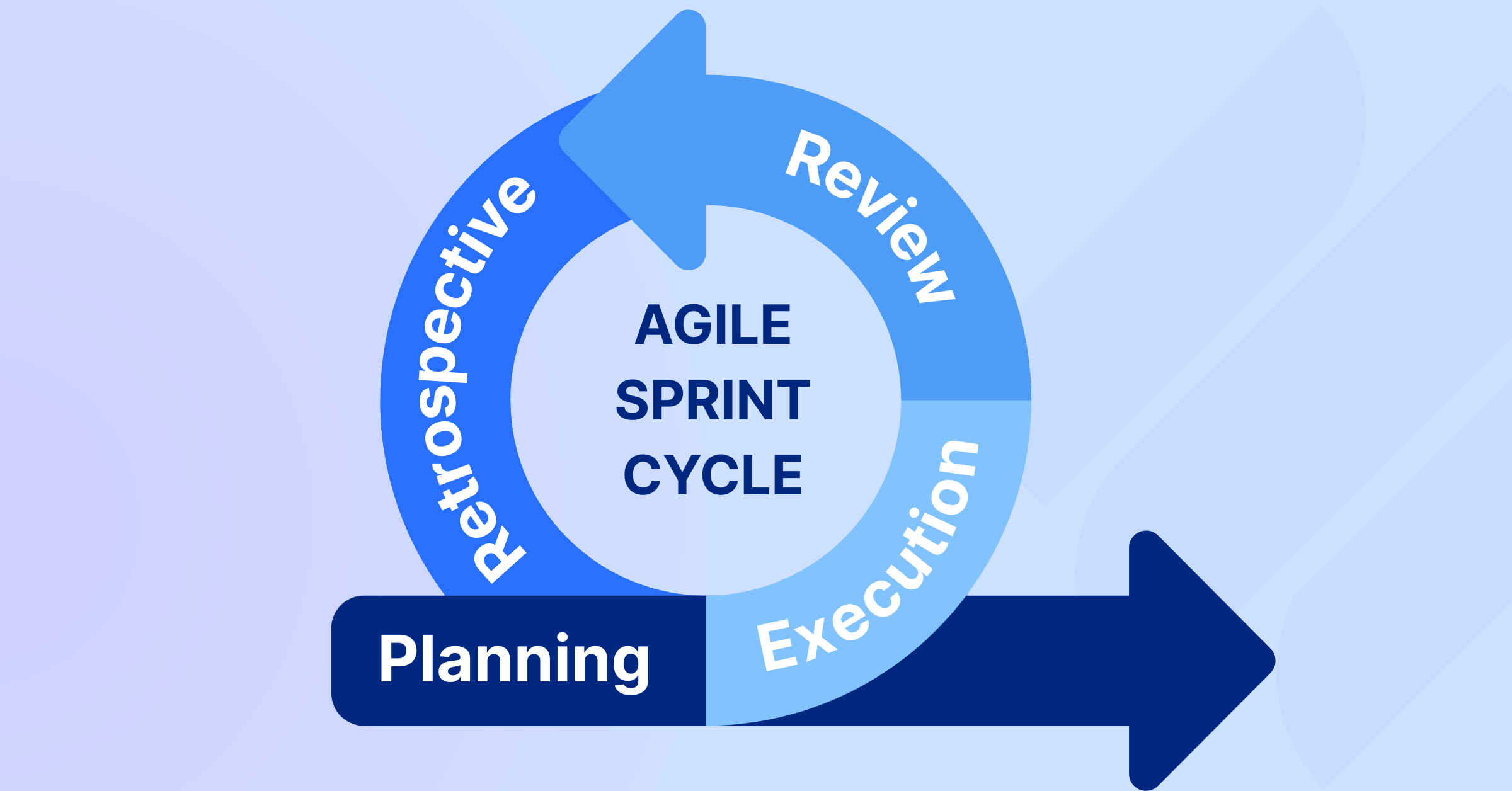How to Fix Broken Scrum Cycles: 7 Early Warning Signs and What to Do About Them
Discover 7 early warning signs of broken Scrum cycles and proven strategies to fix them. Restore agility and boost delivery in Agile project management.
Scrum cycles form the core of Agile project management, enabling teams to deliver value iteratively while fostering collaboration. However, even experienced Agile teams encounter disruptions like inconsistent velocity, scope creep, or team burnout. When scrum cycles falter, many organizations mistakenly enforce stricter rules instead of addressing underlying issues. This guide provides a detailed approach to identifying early warning signs of broken scrum cycles, understanding their root causes, and implementing advanced strategies to restore agility and team alignment.
Understanding the Scrum Cycle
What a Healthy Scrum Cycle Looks Like
A healthy Scrum cycle relies on four interconnected feedback loops: Sprint Planning, Daily Scrum, Sprint Review, and Sprint Retrospective. Each loop contributes to continuous inspection and adaptation, ensuring the team delivers meaningful outcomes. Sprint Planning establishes clear objectives, Daily Scrums maintain momentum and alignment, Sprint Reviews gather stakeholder feedback, and Retrospectives drive process improvements. When these loops function cohesively, teams achieve predictable delivery and maintain strategic alignment.
Why Scrum Cycles Break
Scrum cycles often break when teams prioritize process over outcomes, leading to rigid adherence to rituals without delivering value. A disconnect between sprint goals and business strategy can cause work to feel misaligned or irrelevant. Ineffective feedback loops, such as superficial retrospectives, prevent teams from addressing issues. Untracked dependencies or hidden work, like last-minute requests, further disrupt flow and erode trust in the process.
Recognizing Early Dysfunction
Early signs of a broken scrum cycle manifest in subtle but measurable ways. Unpredictable sprint velocity or unreliable forecasts make planning challenging and reduce stakeholder confidence. Disengaged stakeholders during reviews signal a lack of collaboration or unclear goals. Declining quality across sprints, such as increasing defects, indicates process or workload issues. Low team morale or silent retrospectives often point to deeper cultural problems, like overcommitment or lack of psychological safety.
The 7 Early Warning Signs of Broken Scrum Cycles and How to Fix Them
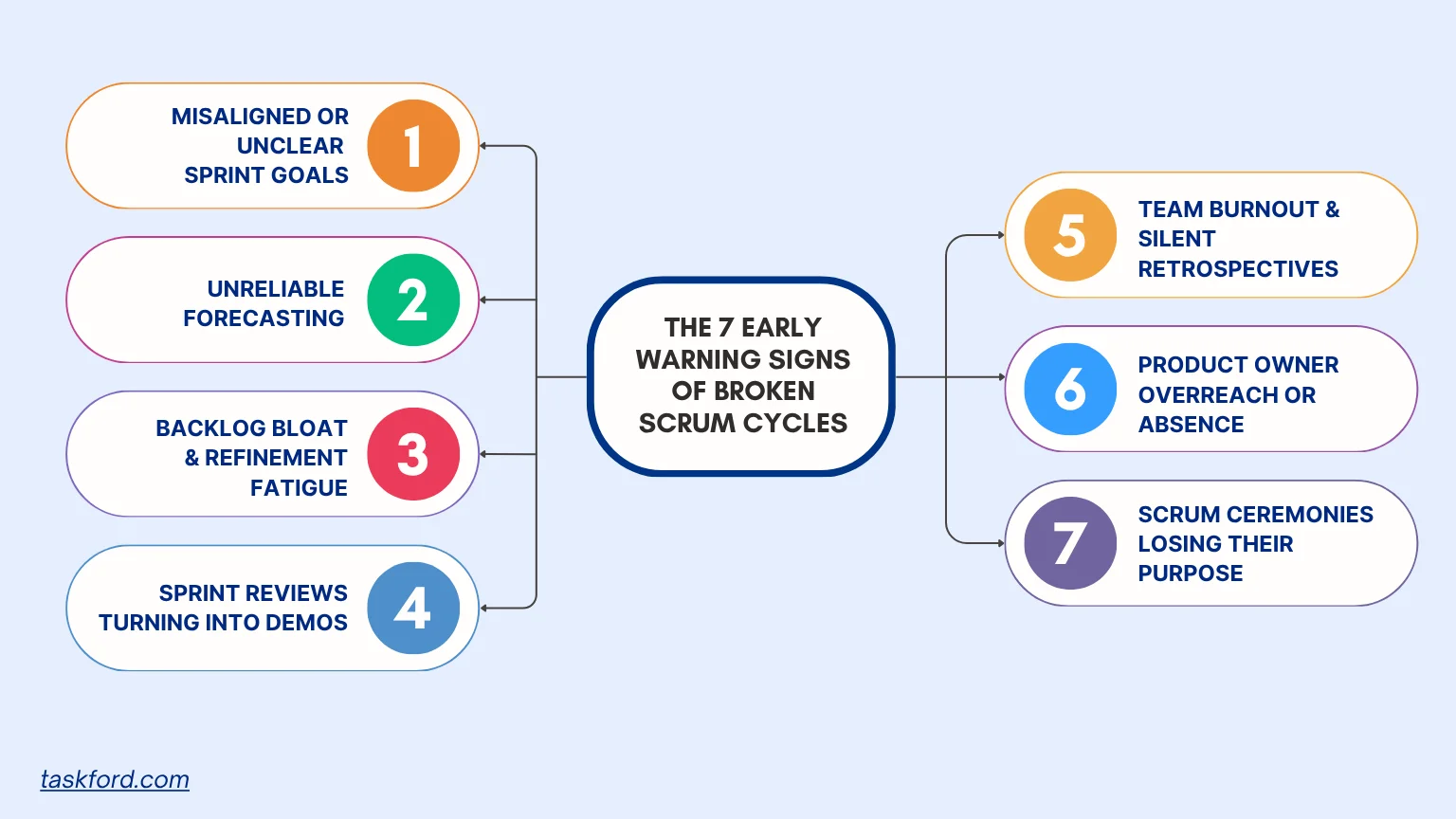
1. Misaligned or Unclear Sprint Goals
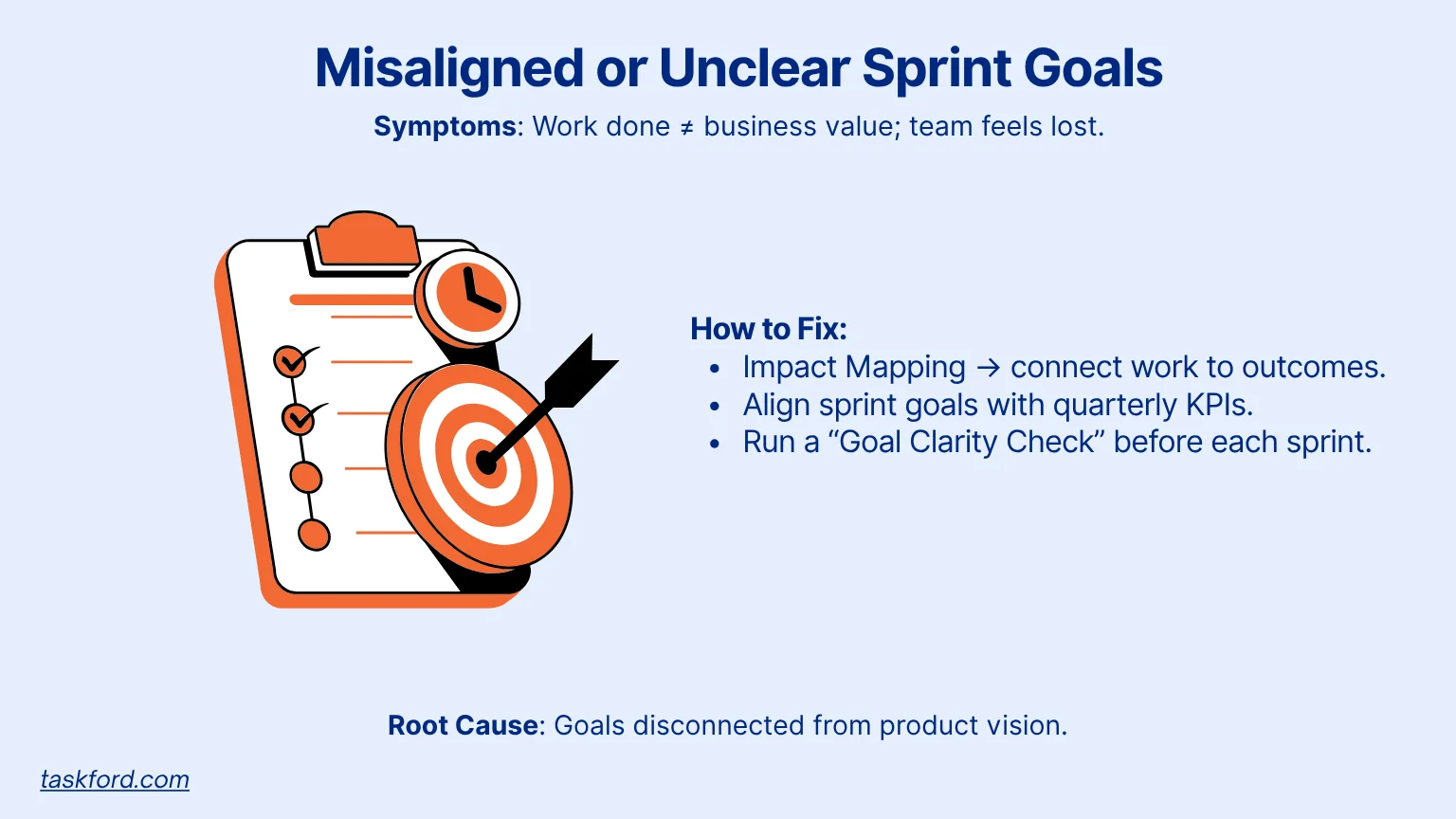
Symptoms: Teams complete tasks, but the work fails to deliver meaningful business impact. Team members feel their efforts lack direction, leading to frustration or disengagement.
Root Causes: Sprint goals often lack a clear connection to the broader product vision, leaving teams unsure of their purpose. Misunderstandings across roles, such as developers and product owners interpreting goals differently, further exacerbate misalignment.
Fixes:
- Use Impact Mapping or Goal-Driven Sprint Planning to tie each user story to specific customer or business outcomes. This approach clarifies how work contributes to strategic goals.
- Align sprint goals with quarterly objectives during planning sessions to ensure relevance and focus. For example, map sprint deliverables to key performance indicators (KPIs) like user retention or revenue growth.
- Conduct a “Goal Clarity Check” before committing to a sprint. Ask each team member to articulate the sprint goal in their own words to confirm shared understanding.
2. Unpredictable Velocity and Unreliable Forecasting
Symptoms: Team output fluctuates significantly from sprint to sprint, making it difficult to predict delivery timelines. Stakeholders lose trust in the team’s ability to meet commitments.
Root Causes: Inconsistent story point estimation, such as assigning different points to similar tasks, creates unreliable velocity metrics. External blockers, like delayed dependencies or unplanned work, disrupt sprint execution and skew forecasts.
Fixes:
- Track the ratio of unplanned work each sprint using your project tracking tool to quantify disruptions. For instance, calculate the percentage of story points allocated to unplanned tasks to identify patterns.
- Apply Monte Carlo simulations to generate data-driven forecasts based on historical velocity data. This statistical method provides a range of likely completion dates, improving planning accuracy.
- Incorporate Earned Value Management (EVM) to balance cost, schedule, and progress visibility. EVM metrics, like cost performance index, help teams assess whether they’re on track to deliver value within budget and time constraints.
3. Backlog Bloat and Refinement Fatigue
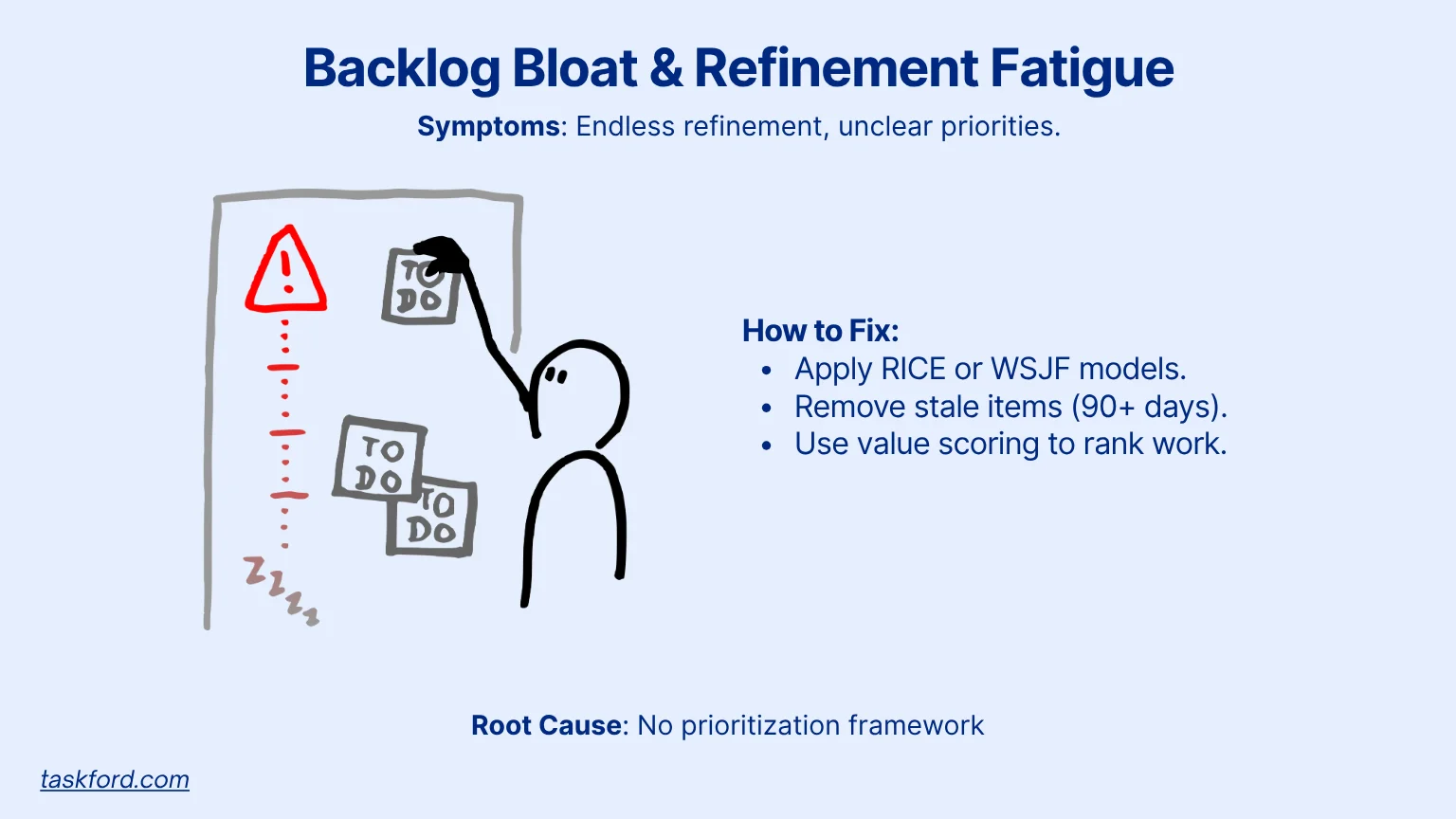
Symptoms: The product backlog grows cluttered with low-value or outdated items, overwhelming the team. Refinement sessions become draining, with little progress toward a prioritized, actionable backlog.
Root Causes: Without a clear prioritization framework, teams struggle to focus on high-impact work. A weak Definition of Ready (DoR) allows vague or poorly defined items to persist, leading to endless debates during refinement.
Fixes:
- Adopt prioritization models like RICE (Reach, Impact, Confidence, Effort) or WSJF (Weighted Shortest Job First) to rank backlog items based on value and effort. These frameworks help teams focus on work with the highest return on investment.
- Implement backlog aging rules, such as reviewing or removing items older than 90 days, to keep the backlog lean and relevant.
- Use your project tracking tool’s value-scoring features to assign numerical scores to backlog items. This approach streamlines refinement by providing a clear, data-driven basis for prioritization.
4. Sprint Reviews Turning into Demos
Symptoms: Sprint Reviews devolve into one-way presentations, with little to no stakeholder input. The lack of collaboration reduces the value of feedback and leaves teams disconnected from business needs.
Root Causes: Teams treat reviews as formalities rather than opportunities for meaningful dialogue. Stakeholders may arrive unprepared or unclear about their role in providing feedback.
Fixes:
- Rebrand Sprint Reviews as learning sessions to shift the focus from polished demos to collaborative discussions. Present progress, insights, and data like business value metrics or customer feedback to spark engagement.
- Encourage live discussions on release readiness and next steps. For example, ask stakeholders to evaluate whether the delivered increment meets acceptance criteria or requires adjustments.
- Include measurable outcomes in reviews, such as user adoption rates, performance improvements, or defect reduction, to ground discussions in tangible results.
5. Team Burnout and Silent Retrospectives
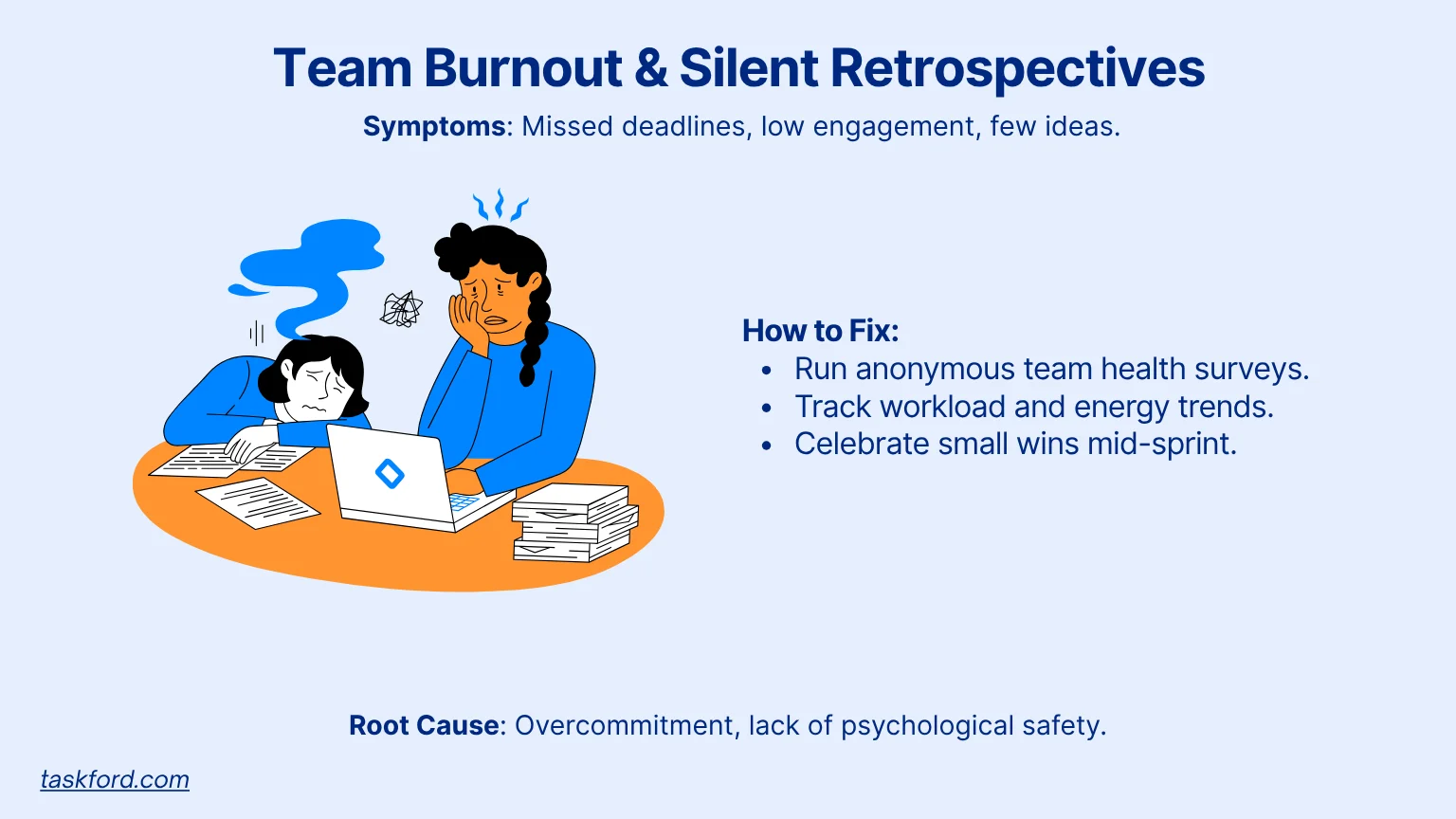
Symptoms: Team engagement declines, deadlines slip, and retrospectives produce few ideas or actionable outcomes. Team members may seem disengaged or hesitant to share honest feedback.
Root Causes: Overcommitment to unrealistic sprint goals leads to unsustainable workloads and burnout. A lack of psychological safety prevents team members from voicing concerns or suggesting improvements.
Fixes:
- Conduct anonymous team health surveys before retrospectives to uncover hidden issues, such as workload imbalances or interpersonal tensions. Tools like Google Forms or your project management system can facilitate this process.
- Use your management dashboard to track workload balance and sprint energy trends. For example, monitor hours allocated per team member to identify over-allocation early.
- Introduce short recognition or reset moments mid-sprint, such as celebrating small wins or hosting brief team-building activities, to sustain morale and engagement.
6. Product Owner Overreach or Absence
Symptoms: The Product Owner either micromanages every decision, stifling team autonomy, or disappears mid-cycle, leaving the team without direction or prioritization.
Root Causes: Unclear boundaries between roles create overlap or gaps in accountability. Weak communication channels between the Product Owner and delivery team exacerbate delays or misaligned priorities.
Fixes:
- Create a role alignment matrix to define decision-making responsibilities for the Product Owner, Scrum Master, and team. This matrix clarifies who owns prioritization, technical decisions, and process facilitation.
- Appoint a supporting product representative, such as a senior team member, to act as a proxy when the Product Owner is unavailable. This ensures continuity in decision-making.
- Schedule quarterly role calibration sessions with leadership and Scrum teams to reinforce accountability and align expectations across roles.
7. Scrum Ceremonies Losing Their Purpose
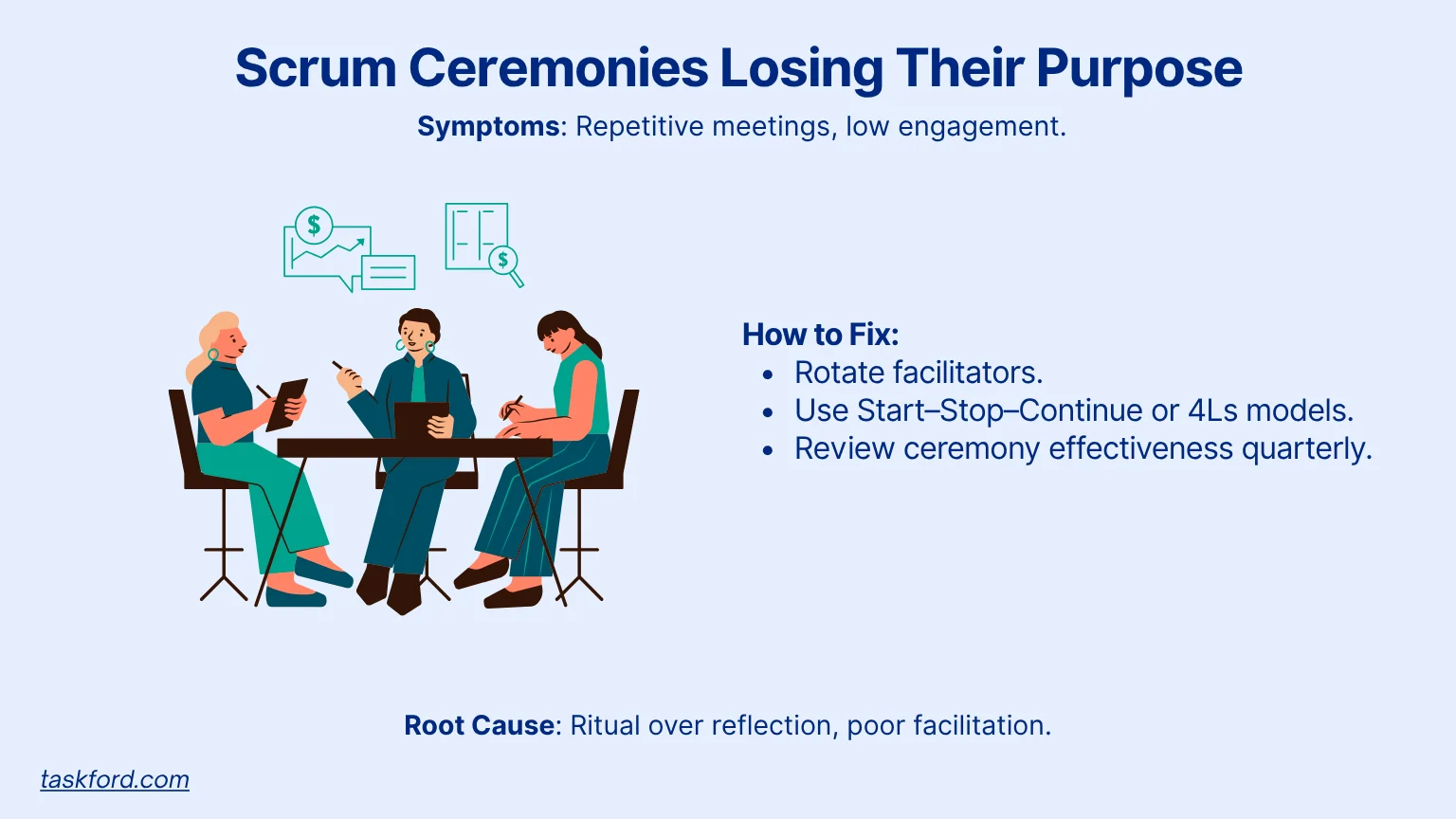
Symptoms: Scrum ceremonies, like Daily Scrums or Retrospectives, feel repetitive, time-consuming, or disconnected from delivering value. Attendance may drop, and discussions lack focus.
Root Causes: Teams prioritize following Scrum rituals over achieving their intended outcomes, leading to disengagement. Inexperienced facilitation or insufficient reflection time further diminishes ceremony impact.
Fixes:
- Rotate facilitation duties among team members to bring fresh perspectives and prevent monotony. For example, a different team member can lead the Daily Scrum each week.
- Use structured reflection formats like 4Ls (Liked, Learned, Lacked, Longed For) to guide discussions and uncover actionable insights.
- Conduct a ceremony effectiveness review every quarter. Ask the team to rate each ceremony’s value and suggest adjustments to improve relevance and engagement.
Diagnosing the Root Cause To Fix Broken Scrum Cycles
Diagnosing the root causes of broken scrum cycles requires a systematic approach to uncover hidden issues and patterns that undermine team performance. Without a clear understanding of these causes, fixes may address symptoms rather than systemic problems, leading to recurring dysfunction. A structured diagnosis involves collecting both qualitative and quantitative data, engaging the team and stakeholders, and leveraging tools to identify trends. This process ensures that interventions target the true sources of disruption, setting the stage for sustainable improvements in scrum cycles.
1. Create a Scrum Health Dashboard
A Scrum Health Dashboard consolidates key metrics to monitor sprint performance and identify issues early. Track indicators like sprint predictability (percentage of committed work delivered), commitment reliability (consistency in meeting goals), escaped defects (bugs found post-sprint), and team morale scores (from surveys or retrospectives). Use your internal analytics or reporting tool to visualize trends, such as velocity fluctuations or defect spikes, to guide improvement efforts.
2. Maintain a Continuous Improvement Backlog
Store identified issues, experiments, and learnings in a dedicated space within your project management system. Prioritize fixes based on their impact versus effort, using a simple scoring system to rank them. Review this backlog during retrospectives to track process maturity and ensure continuous improvement remains a priority.
3. Use an Agile Maturity Model
An Agile Maturity Model is an assessment of how well a company is integrating the Agile Project Management framework into its project. Assess your team’s Agile maturity across dimensions like delivery predictability, feedback loop effectiveness, team autonomy, and role clarity. Create a visual map, scoring or color-coding each dimension to highlight strengths and weaknesses. Revisit this map quarterly to measure progress and prioritize areas for improvement.
Common Pitfalls When Fixing Scrum Cycles
When addressing broken scrum cycles, avoid these common mistakes:
- Treating Scrum rules as rigid checklists, which stifles adaptability and innovation.
- Changing ceremonies without addressing underlying behaviors, such as lack of trust or poor communication.
- Introducing multiple experiments simultaneously, which can overwhelm the team and dilute focus.
- Ignoring leadership’s role in process failures, such as failing to provide clear strategic direction or adequate resources.
Tools and Practices to Sustain Healthy Scrum Cycles
To maintain healthy scrum cycles, teams must leverage tools and practices that provide visibility, foster collaboration, and enable data-driven improvements. These tools and techniques help monitor progress, identify bottlenecks, and ensure alignment across roles, keeping scrum cycles adaptive and effective. By integrating these practices into daily workflows, teams can sustain momentum and prevent dysfunction from recurring.
1. Leverage Project Management Tools
Use your project tracking tools such as TaskFord to monitor sprint progress, velocity trends, and bottlenecks in real time. Key practices include:
- Track Key Metrics: Monitor cycle time, lead time, and work-in-progress limits to identify inefficiencies, such as tasks stuck in progress for too long.
- Visualize Trends: Create custom dashboards to display delivery metrics like unplanned work ratios. Share these with developers, testers, and product leads to ensure cross-role visibility.
- Automate Alerts: Set up notifications for anomalies, such as a sudden spike in defects or a drop in sprint predictability, to enable proactive intervention.
2. Implement Data-Driven Dashboards
Custom dashboards provide actionable insights to sustain scrum cycles. Effective practices include:
- Centralize Data: Aggregate metrics like sprint predictability, commitment reliability, and team morale in a single view to spot trends early.
- Review Regularly: Use dashboards during retrospectives to ground discussions in data. For example, analyze unplanned work trends to adjust planning processes.
- Tailor Visuals: Customize dashboards to highlight role-specific insights, such as defect trends for testers or backlog health for product owners, fostering collaboration.
3. Foster Cross-Role Collaboration
Encourage visibility and alignment across roles to strengthen scrum cycles. Practical steps include:
- Share Access: Ensure developers, testers, and product leads have access to the same project tracking data to align on priorities and progress.
- Hold Cross-Functional Reviews: Conduct regular sessions to review dashboard insights, allowing each role to contribute to process improvements.
- Document Decisions: Record key decisions from reviews or retrospectives in your project management system to maintain transparency and accountability.
Conclusion
A broken scrum cycle signals an opportunity for growth, not failure. By identifying early warning signs, diagnosing root causes, and implementing targeted fixes, teams can rebuild trust, enhance delivery, and restore agility. The key to success lies in evolving scrum cycles to fit the team’s unique context, rather than forcing rigid adherence to a process. With intentional diagnosis, prioritized experiments, and data-driven improvements, your Scrum practice can become a resilient engine for delivering consistent value.
Learn more
- Scrum vs Sprint: Why the Debate Exists and What Teams Really Need to Understand
- What is Project Management? The Complete First Guide for Newbies
- Agile Project Management Sprint Cycle - From Planning to Retrospective
Making work simpler,
smarter, and more connected
Join our waitlist and be notified first.

Related Blog
Subscribe for Expert Tips
Unlock expert insights and stay ahead with TaskFord. Sign up now to receive valuable tips, strategies, and updates directly in your inbox.





